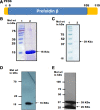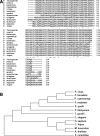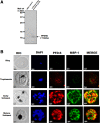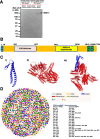Prefoldin subunit 6 of Plasmodium falciparum binds merozoite surface protein-1
- PMID: 33145997
- PMCID: PMC9063436
- DOI: 10.1002/2211-5463.13022
Prefoldin subunit 6 of Plasmodium falciparum binds merozoite surface protein-1
Abstract
Malaria is a human disease caused by eukaryotic protozoan parasites of the Plasmodium genus. Plasmodium falciparum (Pf) causes the most lethal form of human malaria and is responsible for widespread mortality worldwide. Prefoldin is a heterohexameric molecular complex that binds and delivers unfolded proteins to chaperonin for correct folding. The prefoldin PFD6 is predicted to interact with merozoite surface protein-1 (MSP-1), a protein well known to play a pivotal role in erythrocyte binding and invasion by Plasmodium merozoites. We previously found that the P. falciparum (Pf) genome contains six prefoldin genes and a prefoldin-like gene whose molecular functions are unidentified. Here, we analyzed the expression of PfPFD-6 during the asexual blood stages of the parasite and investigated its interacting partners. PfPFD-6 was found to be significantly expressed at the trophozoite and schizont stages. Pull-down assays suggest PfPFD-6 interacts with MSP-1. In silico analysis suggested critical residues involved in the PfPFD-6-MSP-1 interaction. Our data suggest PfPFD-6 may play a role in stabilizing or trafficking MSP-1.
Keywords: Plasmodium falciparum; chaperone; malaria; merozoite surface protein-1; prefoldin.
© 2020 The Authors. Published by FEBS Press and John Wiley & Sons Ltd.
Conflict of interest statement
The authors declare no conflict of interest.
Figures




Similar articles
-
Comparative structural insight into prefoldin subunints of archaea and eukaryotes with special emphasis on unexplored prefoldin of Plasmodium falciparum.J Biomol Struct Dyn. 2022 May;40(8):3804-3818. doi: 10.1080/07391102.2020.1850527. Epub 2020 Dec 4. J Biomol Struct Dyn. 2022. PMID: 33272134 Review.
-
The merozoite surface protein 6 gene codes for a 36 kDa protein associated with the Plasmodium falciparum merozoite surface protein-1 complex.Mol Biochem Parasitol. 2001 Jan 15;112(1):91-101. doi: 10.1016/s0166-6851(00)00350-9. Mol Biochem Parasitol. 2001. PMID: 11166390
-
Proteome analysis reveals a large merozoite surface protein-1 associated complex on the Plasmodium falciparum merozoite surface.J Proteome Res. 2011 Feb 4;10(2):680-91. doi: 10.1021/pr100875y. Epub 2010 Dec 22. J Proteome Res. 2011. PMID: 21175202
-
Merozoite Proteins Discovered by qRT-PCR-Based Transcriptome Screening of Plasmodium falciparum.Front Cell Infect Microbiol. 2021 Dec 9;11:777955. doi: 10.3389/fcimb.2021.777955. eCollection 2021. Front Cell Infect Microbiol. 2021. PMID: 34956931 Free PMC article.
-
Merozoite surface proteins of the malaria parasite: the MSP1 complex and the MSP7 family.Int J Parasitol. 2010 Aug 15;40(10):1155-61. doi: 10.1016/j.ijpara.2010.04.008. Epub 2010 May 6. Int J Parasitol. 2010. PMID: 20451527 Review.
Cited by
-
Prefoldin Function in Cellular Protein Homeostasis and Human Diseases.Front Cell Dev Biol. 2022 Jan 17;9:816214. doi: 10.3389/fcell.2021.816214. eCollection 2021. Front Cell Dev Biol. 2022. PMID: 35111762 Free PMC article. Review.
References
MeSH terms
Substances
Grants and funding
LinkOut - more resources
Full Text Sources
Medical
Research Materials

